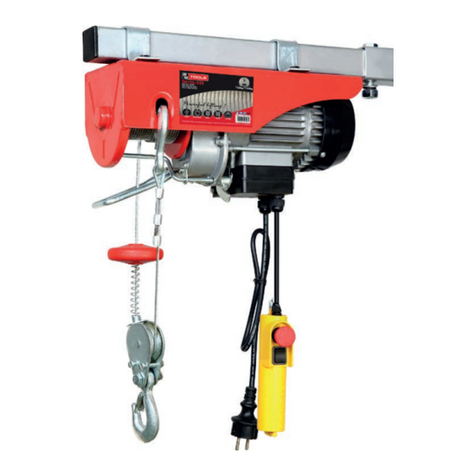
M1.1.PH400-PH400R.NLFREN
2
NL
TOOLS
1 Veiligheid
AANDACHT!
Lees deze instructies et bewaar deze in een veilige plaats voor verdere raadpleging.
We aanvaarden geen aansprakelijkheid in geval van schade als gevolg van het niet-naleven van
deze instructies.
Dit toestel is voor een privé gebruik, niet voor commercieel of professioneel gebruik.
Gebruik het toestel nooit om mensen of dieren te transporteren.
Ga nooit onder een hangende last.
• Houd uw werkruimte net.
• Zorg voor een voldoende verlichting van de werkruimte. Gebruik het toestel niet in een omgeving met een potentieel
brandgevaar, of in een explosiegevaarlijke omgeving, of in de aanwezigheid van brandbare vloeistoffen. Stel het toestel
niet aan regen, damp, zon, stof of kou bloot.
• Vermijd het contact met de geaarde oppervlakken.
• Houd kinderen en onbevoegde personen buiten de werkruimte.
• Overschrijd de maximale draagcapaciteit van de takel niet.
• Gebruik geen 2 of meerdere takels om een voorwerp te tillen.
• Draag nauwsluitende kleren. Draag geen accessoires (juwelen, ...), die door de bewegende delen ingetrokken kunnen
worden.
• Draag de nodige persoonlijke beschermingen (handschoenen, antislip schoenen, oog- en gehoorbeschermingen).
• Houd de voedingskabel ver van hitte, olie en scherpe kanten.
• Controleer de goede toestand van de voedingskabel voor elk gebruik.
• Zorg altijd voor een stabiele lichaamspositie en een goed evenwicht.
• Ontkoppel het toestel van de stroomtoevoer wanneer niet in gebruik en voor onderhoudswerken.
• De takel is voor een binnenshuis gebruik geschikt, gebruik deze niet buitenshuis.
• Controleer de takel voor elk gebruik. Als een onderdeel beschadigd is, moet het onmiddellijk door een professioneel
gerepareerd of vervangen worden.
• Gebruik enkel accessoires, die door de fabrikant aanbevolen zijn.
• Til de lasten op de kleinst mogelijke snelheid vanaf de grond. De kabel moet gespannen zijn, maar niet ontrold wanneer u
begint de last te tillen.
• Als de remmen niet meer werken en de last snel daalt, druk onmiddellijk op de noodstop knop. Neem dan de last weg van
de takel, en laat deze door een professioneel repareren.
• Het is verboden de takel te wijzigen of demonteren.
• Na 20 uren gebruik, en tenminste eenmaal per jaar, moet de takel door een erkende technische dienst grondig onderhoud
worden.
• Bij het gebruik van de draadloze afstandbediening, werk steeds op een zichtbare afstand.
• Gebruik de draadloze afstandbediening niet in een omgeving met een sterk magnetische veld.
• Als het controlelampje aan de onderkant van de sturingsdoos oplicht, vervang de batterij.
• Als het toestel voor een lange periode niet gebruikt wordt, neem de batterij uit de sturingsdoos.
Inhoud
1 Veiligheid.............................................................................................................................................................. 2
2 Technische specicaties........................................................................................................................................... 3
3 Omschrijving ......................................................................................................................................................... 4
4 Toepassingsgebied................................................................................................................................................. 5
5 Voorbereiding........................................................................................................................................................ 5
6 Installatie............................................................................................................................................................... 5
7 Gebruik ................................................................................................................................................................ 6
8 Onderhoud en reiniging.......................................................................................................................................... 7
9 Storingen .............................................................................................................................................................. 8
10 Onderdelen....................................................................................................................................................... 23
11 EG conformiteitsverklaring - PH400....................................................................................................................... 26
12 EG conformiteitsverklaring - Afstandsbediening voor PH400-R.................................................................................. 27
copyrighted document - all rights reserved by FBC































